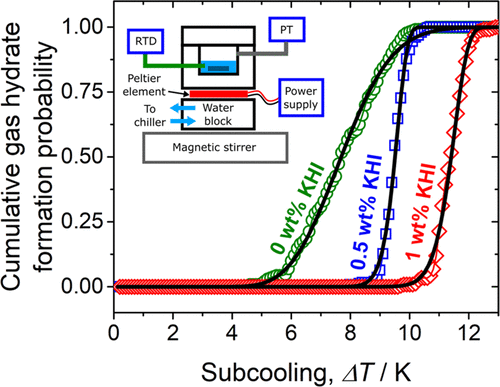Our official English website, www.x-mol.net, welcomes your
feedback! (Note: you will need to create a separate account there.)
Gas Hydrate Formation Probability Distributions: The Effect of Shear and Comparisons with Nucleation Theory
Langmuir ( IF 3.7 ) Pub Date : 2018-02-27 00:00:00 , DOI: 10.1021/acs.langmuir.7b03901 Eric F. May 1 , Vincent W. Lim 1 , Peter J. Metaxas 1 , Jianwei Du 1 , Paul L. Stanwix 1 , Darren Rowland 1 , Michael L. Johns 1 , Gert Haandrikman 2 , Daniel Crosby 3 , Zachary M. Aman 1
Langmuir ( IF 3.7 ) Pub Date : 2018-02-27 00:00:00 , DOI: 10.1021/acs.langmuir.7b03901 Eric F. May 1 , Vincent W. Lim 1 , Peter J. Metaxas 1 , Jianwei Du 1 , Paul L. Stanwix 1 , Darren Rowland 1 , Michael L. Johns 1 , Gert Haandrikman 2 , Daniel Crosby 3 , Zachary M. Aman 1
Affiliation

|
Gas hydrate formation is a stochastic phenomenon of considerable significance for any risk-based approach to flow assurance in the oil and gas industry. In principle, well-established results from nucleation theory offer the prospect of predictive models for hydrate formation probability in industrial production systems. In practice, however, heuristics are relied on when estimating formation risk for a given flowline subcooling or when quantifying kinetic hydrate inhibitor (KHI) performance. Here, we present statistically significant measurements of formation probability distributions for natural gas hydrate systems under shear, which are quantitatively compared with theoretical predictions. Distributions with over 100 points were generated using low-mass, Peltier-cooled pressure cells, cycled in temperature between 40 and −5 °C at up to 2 K·min–1 and analyzed with robust algorithms that automatically identify hydrate formation and initial growth rates from dynamic pressure data. The application of shear had a significant influence on the measured distributions: at 700 rpm mass-transfer limitations were minimal, as demonstrated by the kinetic growth rates observed. The formation probability distributions measured at this shear rate had mean subcoolings consistent with theoretical predictions and steel–hydrate–water contact angles of 14–26°. However, the experimental distributions were substantially wider than predicted, suggesting that phenomena acting on macroscopic length scales are responsible for much of the observed stochastic formation. Performance tests of a KHI provided new insights into how such chemicals can reduce the risk of hydrate blockage in flowlines. Our data demonstrate that the KHI not only reduces the probability of formation (by both shifting and sharpening the distribution) but also reduces hydrate growth rates by a factor of 2.
中文翻译:

天然气水合物形成概率分布:剪切作用和成核理论的比较
天然气水合物的形成是一种随机现象,对于石油和天然气行业中任何基于风险的流量保证方法而言,都具有相当重要的意义。原则上,成熟的成核理论结果为工业生产系统中水合物形成概率的预测模型提供了前景。然而,在实践中,当估计给定输油管线过冷的地层风险或定量动力学水合物抑制剂(KHI)性能时,将依赖于启发法。在这里,我们提出了在剪切作用下天然气水合物系统的形成概率分布的统计显着性测量结果,这些测量结果与理论预测值进行了定量比较。使用低质量,珀尔帖冷却的压力传感器生成了100个以上的点,并在40至-5°C的温度下以高达2 K·min的温度循环–1并使用强大的算法进行分析,这些算法会根据动态压力数据自动识别水合物的形成和初始增长率。剪切力的施加对测得的分布有重大影响:在700 rpm下,传质极限是最小的,如观察到的动力学生长速率所证明。在该剪切速率下测得的地层概率分布具有平均过冷度,与理论预测一致,钢水合物与水的接触角为14至26°。但是,实验分布比预期的要宽得多,这表明在宏观长度尺度上起作用的现象是造成所观察到的大部分随机形成的原因。KHI的性能测试为此类化学物质如何减少流水线中水合物堵塞的风险提供了新的见解。
更新日期:2018-02-27
中文翻译:

天然气水合物形成概率分布:剪切作用和成核理论的比较
天然气水合物的形成是一种随机现象,对于石油和天然气行业中任何基于风险的流量保证方法而言,都具有相当重要的意义。原则上,成熟的成核理论结果为工业生产系统中水合物形成概率的预测模型提供了前景。然而,在实践中,当估计给定输油管线过冷的地层风险或定量动力学水合物抑制剂(KHI)性能时,将依赖于启发法。在这里,我们提出了在剪切作用下天然气水合物系统的形成概率分布的统计显着性测量结果,这些测量结果与理论预测值进行了定量比较。使用低质量,珀尔帖冷却的压力传感器生成了100个以上的点,并在40至-5°C的温度下以高达2 K·min的温度循环–1并使用强大的算法进行分析,这些算法会根据动态压力数据自动识别水合物的形成和初始增长率。剪切力的施加对测得的分布有重大影响:在700 rpm下,传质极限是最小的,如观察到的动力学生长速率所证明。在该剪切速率下测得的地层概率分布具有平均过冷度,与理论预测一致,钢水合物与水的接触角为14至26°。但是,实验分布比预期的要宽得多,这表明在宏观长度尺度上起作用的现象是造成所观察到的大部分随机形成的原因。KHI的性能测试为此类化学物质如何减少流水线中水合物堵塞的风险提供了新的见解。











































 京公网安备 11010802027423号
京公网安备 11010802027423号